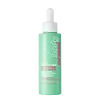What's inside
What's inside
 Key Ingredients
Key Ingredients

 Benefits
Benefits

 Concerns
Concerns

 Ingredients Side-by-side
Ingredients Side-by-side

Water
Skin ConditioningLactic Acid
BufferingPropanediol
SolventAluminum Starch Octenylsuccinate
AbsorbentIsoamyl Laurate
EmollientIsopentyldiol
HumectantDecyl Oleate
EmollientSodium Hydroxide
BufferingCaffeine
Skin ConditioningPhenoxyethanol
PreservativeParfum
MaskingSodium Gluconate
Skin ConditioningSodium Stearoyl Glutamate
CleansingTocopheryl Acetate
AntioxidantXanthan Gum
EmulsifyingCaprylyl Glycol
EmollientNiacinamide
SmoothingTocopherol
AntioxidantHydrogenated Palm Glycerides Citrate
EmollientHexyl Cinnamal
PerfumingLimonene
PerfumingLinalool
PerfumingGeraniol
PerfumingCitral
PerfumingWater, Lactic Acid, Propanediol, Aluminum Starch Octenylsuccinate, Isoamyl Laurate, Isopentyldiol, Decyl Oleate, Sodium Hydroxide, Caffeine, Phenoxyethanol, Parfum, Sodium Gluconate, Sodium Stearoyl Glutamate, Tocopheryl Acetate, Xanthan Gum, Caprylyl Glycol, Niacinamide, Tocopherol, Hydrogenated Palm Glycerides Citrate, Hexyl Cinnamal, Limonene, Linalool, Geraniol, Citral
Water
Skin ConditioningGlycerin
HumectantCaprylic/Capric Triglyceride
MaskingPolyacrylamide
Sodium Hyaluronate
HumectantC13-14 Isoparaffin
EmollientPanthenol
Skin ConditioningTocopheryl Acetate
AntioxidantPhenoxyethanol
PreservativeHydroxypropyl Methylcellulose
Emulsion StabilisingVaccinium Myrtillus Fruit Extract
Skin ConditioningSaccharum Officinarum Extract
MoisturisingAcer Saccharum Extract
Skin ConditioningCitrus Aurantium Dulcis Fruit Extract
MaskingCitrus Limon Fruit Extract
MaskingCaprylyl Glycol
EmollientLaureth-7
EmulsifyingGlycolic Acid
BufferingPolysorbate 20
EmulsifyingPotassium Sorbate
PreservativeHexylene Glycol
EmulsifyingCitric Acid
BufferingParfum
MaskingCI 16035
Cosmetic ColorantCI 15985
Cosmetic ColorantWater, Glycerin, Caprylic/Capric Triglyceride, Polyacrylamide, Sodium Hyaluronate, C13-14 Isoparaffin, Panthenol, Tocopheryl Acetate, Phenoxyethanol, Hydroxypropyl Methylcellulose, Vaccinium Myrtillus Fruit Extract, Saccharum Officinarum Extract, Acer Saccharum Extract, Citrus Aurantium Dulcis Fruit Extract, Citrus Limon Fruit Extract, Caprylyl Glycol, Laureth-7, Glycolic Acid, Polysorbate 20, Potassium Sorbate, Hexylene Glycol, Citric Acid, Parfum, CI 16035, CI 15985
Ingredients Explained
These ingredients are found in both products.
Ingredients higher up in an ingredient list are typically present in a larger amount.
Caprylyl Glycol is a humectant and emollient, meaning it attracts and preserves moisture.
It is a common ingredient in many products, especially those designed to hydrate skin. The primary benefits are retaining moisture, skin softening, and promoting a healthy skin barrier.
Though Caprylyl Glycol is an alcohol derived from fatty acids, it is not the kind that can dry out skin.
This ingredient is also used as a preservative to extend the life of products. It has slight antimicrobial properties.
Learn more about Caprylyl GlycolParfum is a catch-all term for an ingredient or more that is used to give a scent to products.
Also called "fragrance", this ingredient can be a blend of hundreds of chemicals or plant oils. This means every product with "fragrance" or "parfum" in the ingredients list is a different mixture.
For instance, Habanolide is a proprietary trade name for a specific aroma chemical. When used as a fragrance ingredient in cosmetics, most aroma chemicals fall under the broad labeling category of “FRAGRANCE” or “PARFUM” according to EU and US regulations.
The term 'parfum' or 'fragrance' is not regulated in many countries. In many cases, it is up to the brand to define this term.
For instance, many brands choose to label themselves as "fragrance-free" because they are not using synthetic fragrances. However, their products may still contain ingredients such as essential oils that are considered a fragrance by INCI standards.
One example is Calendula flower extract. Calendula is an essential oil that still imparts a scent or 'fragrance'.
Depending on the blend, the ingredients in the mixture can cause allergies and sensitivities on the skin. Some ingredients that are known EU allergens include linalool and citronellol.
Parfum can also be used to mask or cover an unpleasant scent.
The bottom line is: not all fragrances/parfum/ingredients are created equally. If you are worried about fragrances, we recommend taking a closer look at an ingredient. And of course, we always recommend speaking with a professional.
Learn more about ParfumPhenoxyethanol is a preservative that has germicide, antimicrobial, and aromatic properties. Studies show that phenoxyethanol can prevent microbial growth. By itself, it has a scent that is similar to that of a rose.
It's often used in formulations along with Caprylyl Glycol to preserve the shelf life of products.
Tocopheryl Acetate is AKA Vitamin E. It is an antioxidant and protects your skin from free radicals. Free radicals damage the skin by breaking down collagen.
One study found using Tocopheryl Acetate with Vitamin C decreased the number of sunburned cells.
Tocopheryl Acetate is commonly found in both skincare and dietary supplements.
Learn more about Tocopheryl AcetateWater. It's the most common cosmetic ingredient of all. You'll usually see it at the top of ingredient lists, meaning that it makes up the largest part of the product.
So why is it so popular? Water most often acts as a solvent - this means that it helps dissolve other ingredients into the formulation.
You'll also recognize water as that liquid we all need to stay alive. If you see this, drink a glass of water. Stay hydrated!
Learn more about Water